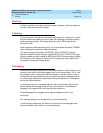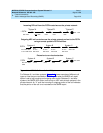
MERLIN LEGEND Communications System Release 6.1
Network Reference
555-661-150
Issue 1
August 1998
Feature Interactions
Page 3-19Primary Rate Interface (PRI) and T1
3
Primary Rate Interface (PRI) and T1 3
“Tandem Trunks” on page 10 and the scenarios in Chapter 2 provide details about
private network routing of incoming outside calls received on PRI and T1 facilities.
Programming is described in Chapter 5, “Network Management
.”
PRI or T1 facilities can be private tandem trunks. Customers order a point-to-point
T1 circuit from a service provider, then use system programming to set it up for
tandem PRI services. It can also be set up for T1-emulated tie service for voice
communications and for data communications (channels must be programmed for
voice or data and are not dynamically allocated). The system also supports
fractional T1 services, allowing you to subscribe to just the number of channels
(from 1 to 23) that are required for T1 voice and/or data. ANI and extension
number/alphanumeric label display are supported on tandem PRI facilities but not
on tandem T1 facilities.
As necessary, a service provider can provide amplification for these tandem
trunks, but does not supply switching services. Tandem PRI facilities provide data
communications at 64 kbps per B-channel (128 kbps for 2B data), while tandem
T1-emulated tie facilities provide data communications at 56 kbps per channel
(112 kbps for 2B data).
Drop-and-insert equipment can be placed between a system and the CO that is
providing the T1 circuit. This allows use of T1 channels for dedicated non-
MERLIN LEGEND/video communications between sites, while keeping the
remaining T1 channels for MERLIN LEGEND traffic. The 24th T1 channel must
not be dropped.
When system programming of the Digital Signal 1 (DS1) switch type as MERLIN
LEGEND-PBX or MERLIN LEGEND-Ntwk identifies a PRI facility as a tandem
trunk, the system selects an unused B-channel group, starting with Group 80 and
counting backward, and assigns all the B-channels to that group. This
programming can be changed after the initial assignment. All the available
B-channels (a maximum of 23) are added to the automatically selected B-channel
group, and any dropped B-channels must be manually deleted from the group.
The D-channel must not be dropped. All 23 B-channels must still be programmed
(as unequipped if not used) and all 24 channels, including the D-channel, count
towards the system maximum of 80 lines/trunks.
PRI and T1 tandem trunks require the same initial DS1 programming (clock
synchronization, framing format, and so on) that other PRI facilities do. However,
routing, network service, and copy telephone number settings are programmed
automatically by the system and cannot be changed unless the switch type is
modified first. For details, see Chapter 5, “Network Management,” and
System
Programming.


















